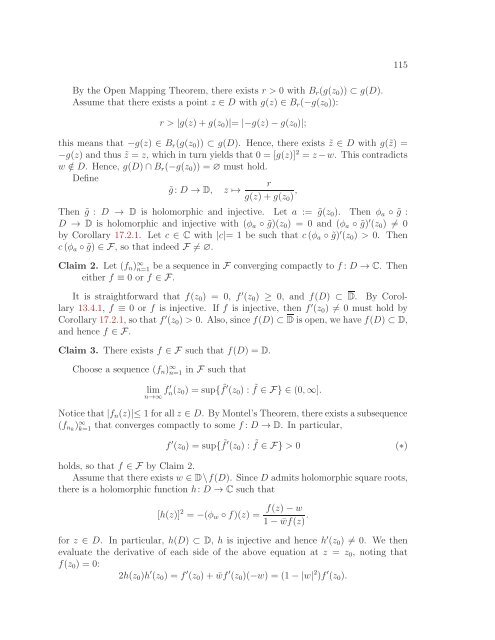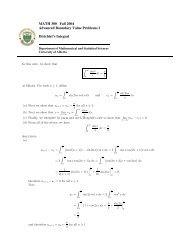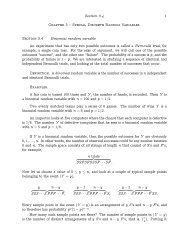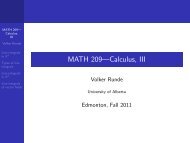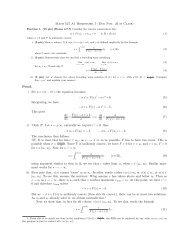Math 411: Honours Complex Variables - University of Alberta
Math 411: Honours Complex Variables - University of Alberta
Math 411: Honours Complex Variables - University of Alberta
Create successful ePaper yourself
Turn your PDF publications into a flip-book with our unique Google optimized e-Paper software.
By the Open Mapping Theorem, there exists r > 0 with Br(g(z0)) ⊂ g(D).<br />
Assume that there exists a point z ∈ D with g(z) ∈ Br(−g(z0)):<br />
r > |g(z)+g(z0)|= |−g(z)−g(z0)|;<br />
this means that −g(z) ∈ Br(g(z0)) ⊂ g(D). Hence, there exists ˜z ∈ D with g(˜z) =<br />
−g(z) and thus ˜z = z, which in turn yields that 0 = [g(z)] 2 = z−w. This contradicts<br />
w /∈ D. Hence, g(D)∩Br(−g(z0)) = ∅ must hold.<br />
Define<br />
˜g: D → D, z ↦→<br />
r<br />
g(z)+g(z0) ,<br />
Then ˜g : D → D is holomorphic and injective. Let a := ˜g(z0). Then φa ◦ ˜g :<br />
D → D is holomorphic and injective with (φa ◦ ˜g)(z0) = 0 and (φa ◦ ˜g) ′ (z0) �= 0<br />
by Corollary 17.2.1. Let c ∈ C with |c|= 1 be such that c(φa ◦ ˜g) ′ (z0) > 0. Then<br />
c(φa ◦ ˜g) ∈ F, so that indeed F �= ∅.<br />
Claim 2. Let (fn) ∞ n=1<br />
115<br />
be a sequence in F converging compactly to f: D → C. Then<br />
either f ≡ 0 or f ∈ F.<br />
It is straightforward that f(z0) = 0, f ′ (z0) ≥ 0, and f(D) ⊂ D. By Corollary<br />
13.4.1, f ≡ 0 or f is injective. If f is injective, then f ′ (z0) �= 0 must hold by<br />
Corollary17.2.1, so that f ′ (z0) > 0. Also, since f(D) ⊂ D isopen, we have f(D) ⊂ D,<br />
and hence f ∈ F.<br />
Claim 3. There exists f ∈ F such that f(D) = D.<br />
Choose a sequence (fn) ∞ n=1<br />
in F such that<br />
lim<br />
n→∞ f′ n (z0) = sup{ ˜ f ′ (z0) : ˜ f ∈ F} ∈ (0,∞].<br />
Noticethat|fn(z)|≤ 1forallz ∈ D. ByMontel’s Theorem, thereexists asubsequence<br />
that converges compactly to some f: D → D. In particular,<br />
(fnk )∞ k=1<br />
f ′ (z0) = sup{ ˜ f ′ (z0) : ˜ f ∈ F} > 0 (∗)<br />
holds, so that f ∈ F by Claim 2.<br />
Assume that there exists w ∈ D\f(D). Since D admits holomorphic square roots,<br />
there is a holomorphic function h: D → C such that<br />
[h(z)] 2 = −(φw ◦f)(z) = f(z)−w<br />
1− ¯wf(z) .<br />
for z ∈ D. In particular, h(D) ⊂ D, h is injective and hence h ′ (z0) �= 0. We then<br />
evaluate the derivative <strong>of</strong> each side <strong>of</strong> the above equation at z = z0, noting that<br />
f(z0) = 0:<br />
2h(z0)h ′ (z0) = f ′ (z0)+ ¯wf ′ (z0)(−w) = (1−|w| 2 )f ′ (z0).


